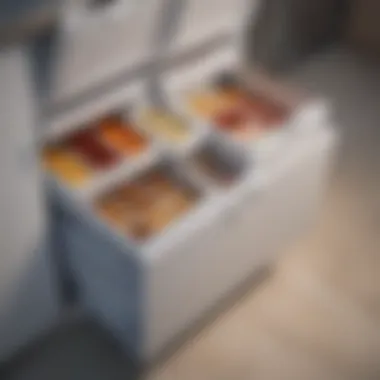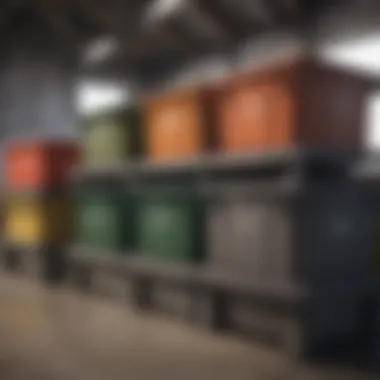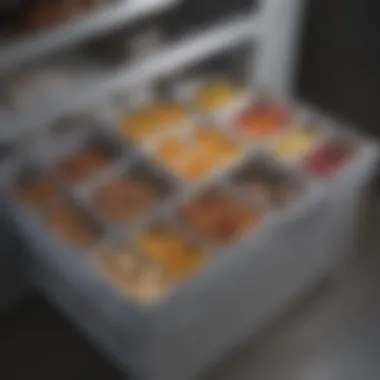Maximize Your Chest Freezer with Stackable Bins


Intro
Organizing a chest freezer can seem like a daunting task, especially when confronted with the assorted packages and frozen foods that tend to accumulate over time. Many homeowners grapple with the challenge of maximizing storage while maintaining easy access to items. The answer to this common dilemma may lie in stackable bins, a solution designed to enhance organization, optimize space, and simplify retrieval.
In this article, we’ll explore the distinct advantages that stackable bins bring to chest freezers. From different materials and designs to practical strategies for implementation, we’ll guide you through each facet of optimizing your freezer storage. By the time you finish reading, you’ll be equipped with actionable advice to elevate your freezer organization game and improve food preservation for long-term storage.
Let's dive into the intricacies of layout and design!
Intro to Chest Freezer Storage
When it comes to managing your food supplies, the chest freezer can be a real lifesaver. However, an unorganized appliance can turn into a frustrating black hole where food goes to die—never to be seen again until you pry it open for an inventory check months later. Getting your act together with some thoughtful storage practices using stackable bins can result in a neat and efficient system.
Understanding Chest Freezers
Chest freezers are typically larger than their upright counterparts, providing ample room for bulk food storage. They are akin to your grandparent's old trunk—difficult to rummage through if not organized properly. One of the strengths of a chest freezer is its energy efficiency, keeping your groceries frozen solid while saving a few bucks on your energy bill.
These freezers maintain an even temperature, making them ideal for long-term food storage. But the design doesn't do the heavy lifting for you; you need to make a plan. This is where stackable bins come into the picture. Using these bins can create a clear, organized system that lets you see what you have at a glance, minimizing those "Oh no, we forgot we had that!" moments.
The Importance of Organization
Have you ever opened a chest freezer only to be hit with frozen air and the shaky certainty that ice cream isn’t the only thing hiding in there? Not to mention, finding food items can quickly morph into a scavenger hunt. Effective organization not only enhances accessibility but also prolongs the quality of your frozen foods. When items are easily reachable, you significantly reduce the time the lid is open, preserving the cold.
Good organization also means less food waste. You’ll actually know what you have and when it needs to be consumed, thus avoiding the dreaded expiration date surprises that happen with freezer burn. This article aims to educate you on how stackable bins are not just a trend, but become a game changer in managing your chest freezer effectively.
By focusing on the relevance of understanding the capabilities of your freezer and the critical importance of organization, your journey into optimizing storage with stackable bins will not just be practical but also enjoyable.
Benefits of Using Stackable Bins
When it comes to organizing a chest freezer, stackable bins are not just a nice-to-have; they are an essential tool. The advantages go beyond mere aesthetics; they encompass practicality, space optimization, and even the longevity of your stored food items. Regardless if you're predominantly storing frozen vegetables, meats, or homemade meals, understanding the exact benefits of using stackable bins can take your freezer organization to another level.
Maximizing Vertical Space
One of the most predominant advantages of stackable bins is their ability to utilize vertical space effectively. Chest freezers, by their design, often have a depth that can make accessing items a real chore. By introducing stackable bins, you create layers within your freezer. This not only allows you to store more items in the same footprint but also makes it easier to reach what you need. For instance, if you are a meal prep enthusiast, you can have your prepped dinner components stacked high, sorted by meal type or dietary preference.
Furthermore, maximizing vertical space means that items at the bottom of the freezer don’t get lost in the abyss. These bins also keep everything organized, reducing the likelihood of having to rummage through bags.
Enhanced Accessibility
Another compelling reason to adopt stackable bins is the improvement in accessibility. With everything arranged neatly, you reduce the time spent searching for that elusive bag of frozen blueberries hidden beneath a mountain of other items. Need to grab a quick snack or a specific ingredient? Simply pull out the stackable bin you need, and you’re golden. This ease of access can also encourage smarter habits, like returning more items to their designated spots after use, rather than tossing them back in haphazardly.
It's also worth mentioning that stackable bins often come with handles, which makes lifting them in and out effortless. If you’re the type that makes multiple trips to the freezer for various items, these features can save you time and frustration.
Food Preservation and Freshness
Stackable bins do more than just keep your freezer organized; they also play a role in preserving your food. When food items are thrown together, they can be prone to freezer burn, which is the last thing you want. Bins provide a contained environment that minimizes air exposure, helping to maintain the quality of your frozen goods.
Additionally, using clear bins made from materials like plastic can give you visibility into what you have on hand. You don’t need to excavate through frozen packages to check what’s inside, and this can drastically cut down on the time it takes to find meals or ingredients. Rather than worrying about the quality of ingredients, you can focus on creativity in the kitchen.
When you maintain both organization and food quality, you ensure that your freezer has longevity, reducing waste and saving money over time.
In sum, the benefits of stackable bins in your chest freezer are multifaceted. They maximize space, enhance accessibility, and help preserve the freshness of your food—all crucial elements for ensuring your food storage system functions seamlessly. For homeowners, interior design enthusiasts, or anyone who enjoys cooking, implementing these bins can make your culinary endeavors far more efficient.
Types of Stackable Bins
Understanding the various types of stackable bins is crucial to optimizing the space in your chest freezer. Selecting the right kind of bin can make a world of difference, both in terms of how much you can store and how easily you can access the items. Factors such as material and design variations play a significant role in your overall storage solution. Each type of bin offers its own unique set of advantages and drawbacks, which can impact not only organization but also the longevity and freshness of your frozen foods.


Material Considerations
Plastic Bins
Plastic bins are a popular choice for chest freezers and for good reason. They are lightweight, which makes them easy to handle even when packed full. Additionally, they typically come with good insulation properties, helping maintain temperature stability within the bin. One standout feature is that many are designed to be transparent, allowing for quick visual identification of contents. However, keep in mind that while they are durable, they can become brittle over time, especially in extremely low temperatures.
Advantages:
- Lightweight and easy to manage.
- Often transparent, allowing for easy content visibility.
- Affordable and widely available.
Disadvantages:
- Can become brittle in extreme cold.
- Not all plastics are food-safe, so verify labels before purchase.
Metal Bins
Metal bins offer durability and a sleek aesthetic that can fit nicely into modern kitchen decor. They are known for their sturdiness, which makes them suitable for heavy items. Unlike plastic, metal bins are less likely to crack under low temperatures. They can also provide an excellent barrier against moisture and odors, enhancing food preservation. However, they may weigh more compared to plastic bins and can also be pricier.
Advantages:
- Strong and long-lasting.
- Better odor and moisture barrier.
- Generally safe for contact with food.
Disadvantages:
- Heavier and can be cumbersome.
- More expensive than plastic alternatives.
Fabric Bins
Fabric bins are gaining attention as a flexible storage option. They offer the advantage of being foldable, which makes them easy to store when not in use. Often made from breathable materials, they can help reduce moisture buildup within the freezer. While they don’t provide the rigid structure that plastic or metal bins do, they’re usually lighter and can fold neatly into corners. Keep in mind, however, that they may not be as durable in the long-term, especially if frequently exposed to moisture.
Advantages:
- Lightweight and easy to store.
- Breathable materials can reduce moisture.
Disadvantages:
- Not as durable as plastic or metal.
- May require more frequent cleaning.
Design Variations
Clear Bins for Visibility
The design of using clear bins is principal for visibility and increases efficiency. Clear bins allow users to quickly spot what they need without rummaging through everything else. This feature not only saves time but also helps maintain an organized freezer environment. Such bins often come with lids, providing a way to stack while keeping items protected.
Advantages:
- Easy to identify contents at a glance.
- Helps in maintaining organization within the freezer.
Disadvantages:
- May stain over time if exposed to certain foods.
- Requires careful handling to avoid breakage.
Colored Bins for Categorization
Colored bins can provide a delightful way to teach organization through visual cues. By assigning different colors to various categories of food, it can make locating and storing items a breeze. For instance, a specific color for meat, another for vegetables, and so on. This strategy brings structure to what might otherwise be a chaotic storage situation.


Advantages:
- Visually appealing and engaging.
- Encourages better organization by category.
Disadvantages:
- May not be clear about contents unless labeled.
- Some colors may fade over time with exposure to cold.
Compartmentalized Bins for Specific Uses
Compartmentalized bins are designed for precision. They are perfect for separating small items or ingredients that you don’t want mixing together. For example, you might have one compartment for fish fillets and another for ice cream containers. This design takes organization to the next level by ensuring that everything stays in its designated space, simplifying access and minimizing mess.
Advantages:
- Provides maximum organization for small items.
- Reduces risk of cross-contamination among different food types.
Disadvantages:
- Less flexible than other bin types; less ideal for bulk items.
- Can be more challenging to clean due to multiple compartments.
Choosing the Right Stackable Bin
When it comes to optimizing your chest freezer storage, selecting the right stackable bin is essential. This choice significantly impacts organization, space maximization, and ultimately, your ability to preserve food quality. Getting it right means understanding your specific needs and the available options out there, effectively balancing practicality with personal preferences.
Assessing Freezer Dimensions
Before diving into the maze of stackable bins available on the market, it's crucial to assess your chest freezer's dimensions. Knowing the measurements helps ensure that your chosen bins won't be a square peg trying to fit into a round hole.
Take the time to measure both the interior height and width of your freezer. It's not only about the overall space but also acknowledging any unique structures within, such as shelves or coils. With these numbers on hand, you can strategically select bins that complement the available space without wasting any.
Establishing Storage Needs
With your freezer dimensions in hand, it’s time to identify your storage needs. Understanding what you’ll be placing inside those bins is critical. Are you stashing away big bags of frozen vegetables, or are you dealing with smaller items like herbs or prepped meals? Each scenario calls for a different type of bin.
- Consider frequency of use: Regularly used items should be easily accessible. In contrast, seasonal or occasional items could go deeper into the freezer.
- Type of food: Think about categorizing foods as well. Meat, veggies, and premade meals could all have their respective bins. Tailoring the choice of bins based on food type can further streamline organization.
Evaluating Bin Capacity and Size
After zeroing in on your needs, moving on to capacity and size evaluation is next. Not all bins are created equal—ensure to choose bins that can handle the weight and volume of the items you intend to store. For instance, a slim design might work wonders for vegetables but may struggle under the weight of frozen meat.
- Weight capacity: Many bins are rated for specific weight. Understanding which foods weigh more will aid in making the correct choice.
- Size variations: You might want a mix of sizes; small bins for herbs and large bins for bulk items like bags of frozen fruit. The trick is finding a blend that works for both visibility and accessibility.
Tip: Always keep your environment in check. If you see that certain bins aren’t meeting your needs, don’t hesitate to switch things up! Adaptability is key to maintaining an organized system.
Strategies for Organizing Your Chest Freezer
When it comes to maximizing the utility of your chest freezer, strategies for organizing it effectively cannot be overlooked. A disorganized freezer can lead to food waste, confusion, and even frustration when it comes time to locate that bag of frozen peas or a delicious homemade casserole. Implementing solid organizational tactics not only helps in making the most out of your space but also improves accessibility and enhances the overall longevity of your stored items.
Categorizing Food Items
One of the most impactful strategies for freezer organization is categorizing food items. By grouping similar items together, you can create a visual map of your chest freezer that can save you time and effort. This could mean separating meats, vegetables, prepared meals, and baked goods into their own bins.
Think about your cooking habits. If you often find yourself reaching for vegetables, keeping them at the top or front of the freezer makes sense, so they’re easy to access. Furthermore, consider how often you use certain items. Keeping frequently used foods closer to the top or the openings will keep you from digging through a pile of frozen ears of corn just to get to that lasagna you made a month ago.
Another handy tip is to use distinct bins to help with categorization. For example, using one bin for breakfast items like breakfast burritos and waffles, and another for lunch items like soups and sandwiches. Visual cues matter. Over time, you will start to recognize where certain foods are located, reducing decision fatigue on busy mornings.
Implementing a Rotating System


In the world of food storage, the saying, "first in, first out" rings especially true. Implementing a rotating system within your chest freezer can drastically enhance food quality and reduce waste. This approach revolves around placing new items behind older ones, ensuring that you consume your oldest frozen items first. Not only does this maintain the freshness of your food, but it also helps in keeping track of what needs to be used soon.
To make the most of this system, establish a regular check-in schedule—perhaps once a month. During your check, look through your chest freezer and rotate items as necessary. You might find that some foods, like ground beef, need to make their way to the front of the line before they lose their quality.
For an extra layer of complexity, consider using a simple spreadsheet or note on your fridge to track what’s inside your freezer. It can serve as a reminder of what needs to be eaten and when!
Labeling Bins for Efficiency
Labels can be game-changers when it comes to keeping your chest freezer organized. It may seem trivial, but labeling bins can significantly improve your efficiency while looking for items. The easier it is to identify contents, the less time you'll spend rummaging around.
Take the time to invest in waterproof labels or create your own using a simple label maker. Be clear and straightforward; specify what each bin contains and even include dates for when the items were stored. This way, you won’t inadvertently reach for something that’s been sitting there long past its expiration.
Additionally, consider using color-coded labels for different categories, such as blue for meats, green for vegetables, and red for prepared meals. This visual differentiation makes it easy to glance and see where things belong, ensuring everything has a place. Labels not only help you find what you need quickly, but they also encourage consistency in keeping the organizational system you’ve established.
"An organized freezer is not just about storage; it’s about mindful consumption and waste reduction."
Following these strategies can make a significant difference in how well you utilize your chest freezer. Each step you take towards better organization brings you closer to a more manageable and efficient storage system. With categorized food bins, a rotating practice, and effective labels, you’ll find that navigating your freezer becomes a breeze.
Maintenance and Best Practices
Taking proper care of your chest freezer isn't just about keeping it clean; it's a key aspect of maximizing the benefits of stackable bins. Well-maintained freezers not only enhance food preservation but also ensure that you can easily access your stocked items without a hitch. When you implement a routine maintenance plan, you’re making sure that all systems are go, creating an organized and efficient storage solution. There are several vital components of maintenance that one must consider, which, if overlooked, could lead to untidy situations and even wasted food.
Regular Cleaning and Inspection
Cleaning your chest freezer is more than just a seasonal chore; it’s a necessity. A simple wipe-down inside can prevent unpleasant odors and ensure food safety. When crumbs and spills accumulate, the risk of contamination rises, affecting not only flavor but also your family’s health. Here are a few key pointers for regular cleaning and inspection:
- Frequency: Aim for a thorough cleaning every three months. This includes defrosting if your model requires it.
- Tools Needed: Use mild soap, warm water, and a soft cloth or sponge. Avoid harsh chemicals that could damage the linings.
- Inspecting the Seals: Regularly check the door seals to ensure they’re airtight. A loose seal can lead to frost buildup and increased energy costs.
Each cleaning session is also a prime opportunity to inspect your stackable bins. Make sure they’re intact, with no cracks or signs of wear. If any bins look like they’ve had better days, replace them to maintain an organized setup.
"A clean freezer is a happy freezer, reflecting care and consideration that pays off with prolonged food freshness."
Monitoring Storage Conditions
Understanding the conditions inside your chest freezer can make a sizable difference in how long food lasts. The aim here is to strike a balance; too cold can dry out certain foods while too warm can spoil them. Some tips include:
- Thermometer Check: Invest in an appliance thermometer to keep tabs on the internal temperature. The ideal range is between -10°F and 0°F, ensuring food remains in peak condition.
- Humidity Control: If moisture builds up, it can lead to freezer burn. Seek stackable bins that offer some level of humidity control, like those designed with venting systems.
- Freezer Placement: Ensure the chest freezer is in a well-ventilated area, avoiding spots directly in sunlight. A shaded environment helps maintain consistent internal temperatures.
Updating Inventory Regularly
Keeping a running list of what’s stashed away in the chest freezer is not just a good idea; it’s essential for usability. Slipping into the habit of regularly updating your inventory could save you from the stress of searching and rediscovering expired items at the bottom of the pile. Consider these strategies:
- Inventory Sheet: Use a simple spreadsheet or dedicated app to jot down dates when you store items. Note what the item is and when it was placed inside.
- Color Coding: If you use colored bins for categorization, try matching them with markers on your inventory sheet for quick and easy reference.
- Periodic Reviews: Set reminders every month or on convenient days to review your inventory. This helps maintain control over stock levels and mitigates waste.
End: The Future of Freezer Organization
When it comes to chest freezer storage, the future shines brightly with the continued evolution of organization techniques. As we move toward a world where space is precious and efficiency is paramount, adopting the latest strategies in freezer management offers numerous benefits. The crux of this article emphasizes that utilizing stackable bins is not merely a trend, but an ongoing revolution in how homeowners can effectively manage their food reserves.
Sustaining Efficiency and Accessibility
Creating a structured system within your freezer ensures that every item holds its place, reducing the oft-cumbersome search for that elusive bag of peas or the forgotten container of chicken stock. Efficiency in organization translates to a significant time-saving. No longer must one groan and sift through layers of food; instead, each stackable bin acts as a mini-repository for specific categories, allowing for quick visibility and retrieval.
Moreover, accessibility means everyone in the household can find what they need without guessing games. From busy parents trying to whip up dinner, to gardening aficionados storing their summer harvests, this structured approach maintains harmony in the kitchen. As time ticks away, having a clear system helps prevent spoilage too. Knowing what's in your freezer, and finding it quickly, keeps wastage at bay.
A notable consideration includes rotation practices, where freshly stored items are placed at the bottom of bins, ensuring that older products are consumed first. This way, you not only sustain efficiency but also ensure every meal is as fresh as it can be.
Encouraging Mindful Freezing Practices
In the grander scheme, nurturing mindful freezing habits cultivates not just an organized freezer, but a more intentional approach to food consumption. Taking time to assess what is worth freezing and which items are likely to be overlooked fosters an eco-conscious mindset. This allows homeowners to consider their purchasing habits and food usage, prompting a holistic evaluation of what they truly need.
Educating oneself about portion control is also key. Preparing meals in suitable sizes for consumption leads to less food waste. For example, when you freeze roasted vegetables in individual portions, you encourage usage over indifference. When each small decision contributes to a more intentional approach, the outcome is positively amplified.



